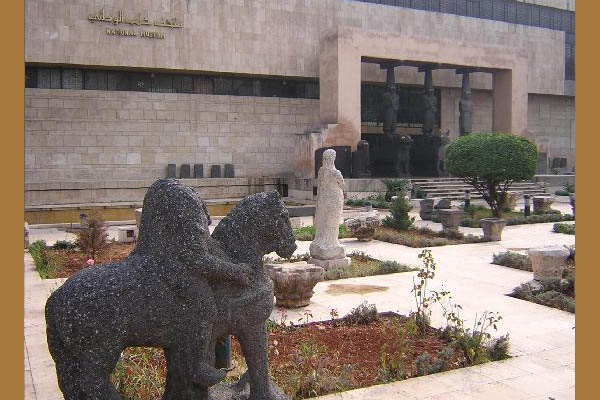At the museum you will witness, starting at the main entrance, a temple gateway and a female sphinx from the Iron Age Neo Hittite settlement in Tell Khallaf.
The first hall exhibits statues and cuneiform slates from Mari in the Bronze Age, including some pieces discovered by Agatha Christie’s husband, Max Mallowan, at the site of Tell Brak (Tell Khouwayra). Further on, you will find a room containing Bronze Age objects from Hama and Ugarit.
Beyond this, you will find a section devoted to Iron Age materials from sites in the Gezira, and Euphrates. Most are Assyrian style statues. The next hall concentrates on objects found in Aleppo, Ain Dara, and Ebla.
On the first floor, there is a part devoted to photographs and various objects from recent foreign expeditions at northern Syrian sites.
There is another hall which is devoted to Modern Art and one devoted to the Greek, Roman and Byzantine periods. This includes coins, mosaics and glassware. In the final hall, you will find the Islamic art section. Fine pottery, coins, illuminated Korans, a 12th-century astrolabe( sextet), and a scale model of Aleppo can all be seen in this room.
The Aleppo souk, unlike the Damascus one, is covered by stone archways for about 30km. This makes it the longest covered souk in the Middle East. Once the most important trade area in Syria, a complicated maze of narrow cobbled streets forms this magnificent Bazaar.
Apart from the Khans, there are many separate souks: cloth, yarns, gold, Women’s clothes, and the spice souk (where you can enjoy a wonderful mixture of odors.)
 Khans
Khans
The central trading positions are Khan Al Gumruk, Khan Al Nahasin, khan alShouneh, Khan Al Sabun, and Khan Al Wazir. Khan al Gumruk (Khan of customs and excise) was built in 1574. It is definitely the largest of Aleppo’s khans, and it was constituted of banks, and the consulates of French, English and Dutch commerce.
This Khan still houses over 250 shops. Khan al Wazir (Khan of the minister) was built as a caravanserai in the 17th century. It is one of the most famous in Aleppo.
It is beautifully decorated; especially the black and white stoned door, and the ornamented outer window frames. Houses of Aleppo .In early Ottoman years, a new Christian suburb called Jadaydah flourished north of the old city wall. Today it is one of the liveliest and most intact of the old neighborhoods.
Impassive stone walls like dikes channel the flow of traffic and conceal the quiet charm of the homes behind them Aleppo’s finest collection of Arab houses from the 17th and 18th centuries. Heavy, half-open doors reveal elegant courtyards and fountains, the most splendid of them in the mansions of the rich, who built prestigiously near the churches.
Houses of Aleppo
The limestone houses, generally of one or two stories, nestle back-to-back to minimize the expanse of wall exposed to sun. Privacy is paramount, so many entrance passageways twist to block courtyards from direct public view. Inside, patios are paved with contrasting flagstones.
Citrus trees, jasmine, and roses grow in basins near fountains or pools. In wealthy homes, a musicians’ stand in the courtyard was used for concerts.
The house called Beit Achakbash, now the “Aleppo Museum of Folk Traditions”, is furnished to depict the sumptuous lifestyle of the wealthy – now largely vanished from the gracious old houses. John Barker, an English consul in Ottoman Aleppo, recorded a wedding celebration in such a house on a summer evening….the courtyards are illuminated at night with different coloured lamps, and nightingales in cages are hired and placed among the shrubs and trees, which sing at intervals when the music ceases.
The dazzling diamonds of the ladies, and the various colors of their dresses, the lights, the singing of the birds, and the trickling of the water falling on the marble basins, made one fancy it to be Fairyland.
Now some of these house were transferred into luxurious hotels and elegant restaurants maintaining the spirit of the past with a modern touch that attracts tourists and allure them to taste the delicious Aleppine plates or to sleep on a bed like that of the Ottoman sultans.
Dar Acheqbach:
This house was built in the 18th century as a typical oriental house with the Iwan, the courtyard and the basement specified for storing commodities, with the rooms of the second floor used as sleeping rooms.
Now the house is transferred into a Museum of Folk Traditions supplied with typical furniture of the region. Several rooms were furnished to represent life in Aleppo in the early 18th century.
Dar Wakeel:
Built in in alSissi alley, alJdaideh quarter. It has a beautiful courtyard with a wonderful marble pond .Walls of one of its rooms was dismantled and sent to the Museum of Berlin, Bergamon wing of Islamic Antiquities, to be displayed under the title of Aleppo Room.
The house was designed by a Persian artist, therefore Persian influence is very clear on the walls and decorations. It was once occupied by an orphanage, and now it is a four star hotel.
Dar Zamraya:
Originally an Ottoman house built in the 18th century, in alJdaideh Quarter. In 1997 it was transferred into a four star hotel with three restaurants and an oriental bath house.
Diwan Rasmi:
Built in the 19th. Century in al Jdaideh quarter and now changed into a three star hotel with two restaurants .The hotel was inaugurated in 2002.
Haifaa Mafalani

